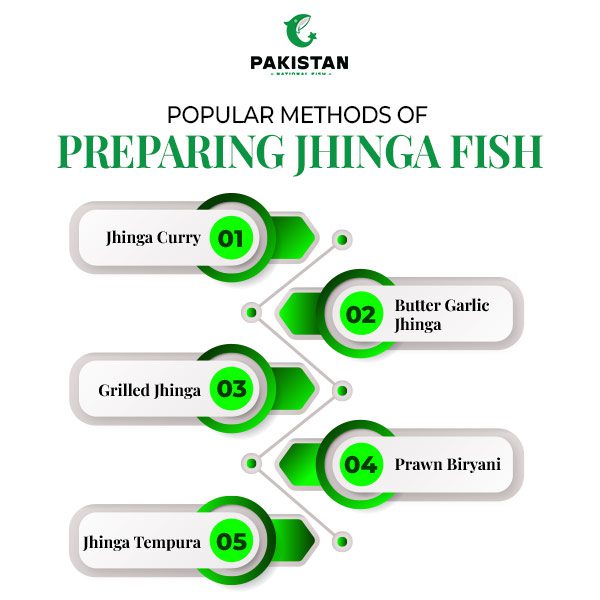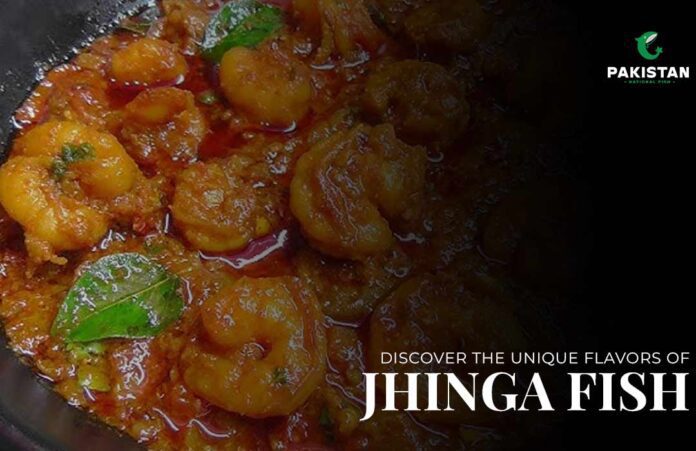Jhinga, which refers to prawns or shrimp, is counted among the favorite seafood components in South Asian countries. Praised for not having a strong fishy odor, its prawn flavor offers a mild sweet taste that can easily be masked and adapted to the chef’s recipe, making Jhinga one of the most popular seafood dishes.
In soup, butter, hot steamy curry, barbecued over charcoal, or deep fried in hot oil, Jhinga prepared in different ways has different mouth feels.
What Makes Jhinga Fish Special?
Prawns (Jhinga) also exist in fresh and sea water and may be small to large; the larger varieties are usually demanded in South Asian and Mediterranean fish cuisine. This fish is suitable for combination with many spices and herbs and has a special, somewhat sweetish, subtle taste one of the main features of the Jhinga.
Jhinga very well retains all the flavor of the spices it is cooked with and therefore is the best food article to experiment with various types of sauces. At the same time, it is tender and sweet, so it will not disappear in hot dishes or get lost in the presence of spices. It is this fine line between flexibility and differentiation that makes the dish of Jhinga make every difference.
Nutritional Values of Jhinga
Besides being tasty, jhinga fish is another healthy fish product people should consider eating. Known to be rich sources of lean protein, omega-3 fatty oil and acids iodized salt, zinc, and selenium, consuming jhinga leads to maintaining health conditions. Omega-3 is useful in the heart and has anti-inflammatory properties as well as iodine for thyroid hormone synthesis.
It also means that this product does not contain a high amount of calories, and is perfect for those people who follow a healthy diet regime but do not wish to skip on taste.
Popular Methods of Preparing Jhinga Fish

1. Jhinga (Prawn) Curry
In this preparation, Jhinga is normally cooked with tomatoes, onions, garlic, and pure spices in a sauce with cumin, coriander, turmeric, chilli, and garam masala. By their nature, the prawns take on the characteristics of the spices while the sauce becomes sweeter from the prawns.
The addition of coconut milk to Jhinga fish curry is standard in some parts of the country especially, near coastal areas to create a slightly sweet, creamy texture of the dish. One thing that I appreciated and wanted to make clear, the balance of the spicy and earthy flavored masala and the natural sweetness of the prawns make this dish very tasty.
Flavor Overview:
- Spices: Bold, earthy, and aromatic
- Curry Base: Creamy, tangy, and rich
- Prawn Flavor: Sweet, tender, and succulent
Regional Variations:
- Goan Prawn Curry: Uses tamarind and coconut milk as some of its ingredients and produces a tangy and sweet taste of the curry.
- Malabari Prawn Curry: Incorporates curry leaves, mustard seeds, and coconut oil, in the preparation process with a view of improving on fragrance.
2. Butter Garlic Jhinga
The use of butter and garlic makes this dish one that can be prepared easily and is actually delicious. The prawns do not need to be soaked in spices because the main ingredient is really delicious in its natural form. These prawns are cooked in butter and a lot of garlic, though an option of lemon zest could sometimes be added.
There is a good, thick, buttery sauce that forms a slightly glossy glaze over the prawns, and the garlic gives the dish that extra Hercules touch. The dish, served as an appetizer or light meal, is quick and deliciously prepared with fresh parsley or cilantro for a burst of freshness.
Flavor Overview:
- Butter: Rich, creamy, and smooth
- Garlic: Pungent, savoury, and aromatic
- Prawn Flavor: Sweet as is with a grainy and slightly chewy texture
3. Grilled Jhinga
The second way to prepare Jhinga is similar to grilling where it is done over a flame to get that grilled smoky charring taste which is equally very favorite for anyone who tends to love seafood. Prawns may be seasoned before grilling in oil and vinegar, olive oil, lemon juice, garlic, and a variety of herbs including parsley and cilantro.
It is used to flavor the prawns so that the prawns remain tender while they are being grilled. Grilled Jhinga, garnished with lemon juice and garden leaves, is a favorite dish for warmer months or seafood feasts, suitable for sample preparation.
Flavor Overview:
- Grill: Smoky and slightly charred
- Marinade: Zesty, herbal, and bright
- Prawn Flavor: Sweet, juicy, and tender
4. Prawn Biryani
Jhinga fish biryani, or prawn biryani, combines the best of both worlds: biryani rice fragrance and sweetness come from prawns. Pulao is made of basmati rice, prawns that have been marinated, and a combination of spices such as cardamom, cinnamon, cloves, and saffron. It frys the prawns with the rice, and then the rice is flavored by the prawns, this then serves the rice spectacularly while spices add an extra dimension to this dish.
Onions are normally fried and they are used to garnish the prawn biryani together with fresh mint and cilantro all of which give the dish a crunchy and fresh look respectively. It has to be prepared a day in advance, which makes it suitable to prepare especially on special occasions or when you need to make a hearty food to feed many people.
Flavor Overview:
- Rice: Lavish, having light air, with the touch of saffron and spices
- Spices: It has a warm, ear ouch, and slight sweetness that gives it the sensation of being down to earth.
- Prawn Flavor: Soft, succulent, and with a gentle sugariness.
5. Jhinga Tempura
For a completely different experience, one meal should be Jhinga tempura, this meal has a relief in that the ingredients to prepare it give it a crispy feeling. This preparatory style is from Japan in which members capture small prawns in a thin and light flour coat and fry until they turn to gold and crunchy.
The major secret when preparing tempura is to make the batter very light so that, the prawn is crispy when bitten without being dominated by the batter. Jhinga tempura, a lighter seafood, is served with a soy sauce, offering a crispy outside and soft, juicy inside, unlike traditional fried shrimp.
Flavor Overview:
- Batter: Crisp, light, and golden
- Dipping Sauce: Savor, It’s a type of salty and slightly sweet and has a full-mouth feel with a faint sweetness.
- Prawn Flavor: Sweet, tender, and juicy


